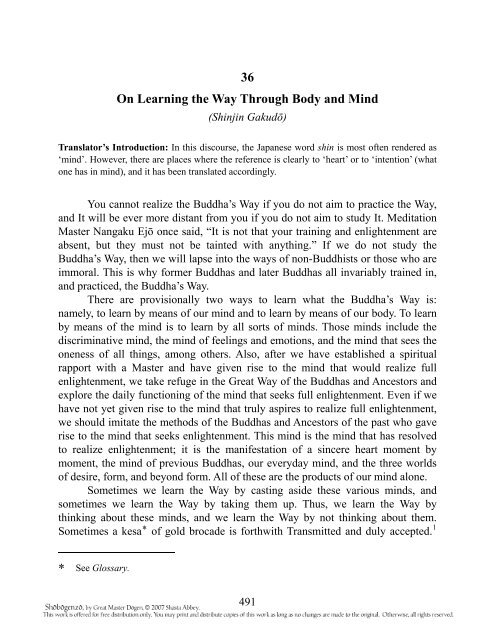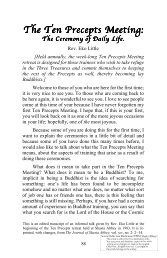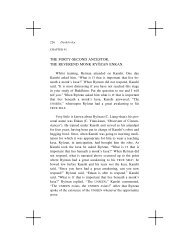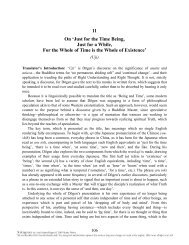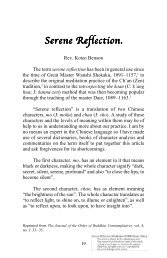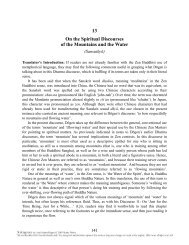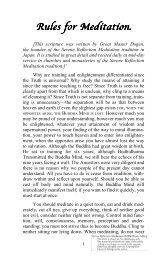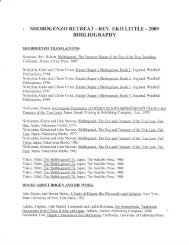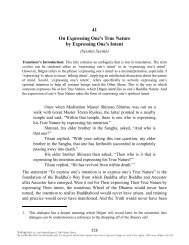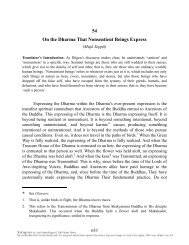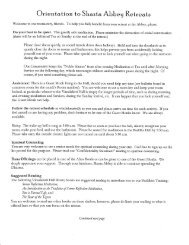Shinjin Gakudo - thezensite
Shinjin Gakudo - thezensite
Shinjin Gakudo - thezensite
Create successful ePaper yourself
Turn your PDF publications into a flip-book with our unique Google optimized e-Paper software.
36<br />
On Learning the Way Through Body and Mind<br />
(<strong>Shinjin</strong> Gakudō)<br />
Translator’s Introduction: In this discourse, the Japanese word shin is most often rendered as<br />
‘mind’. However, there are places where the reference is clearly to ‘heart’ or to ‘intention’ (what<br />
one has in mind), and it has been translated accordingly.<br />
You cannot realize the Buddha’s Way if you do not aim to practice the Way,<br />
and It will be ever more distant from you if you do not aim to study It. Meditation<br />
Master Nangaku Ejō once said, “It is not that your training and enlightenment are<br />
absent, but they must not be tainted with anything.” If we do not study the<br />
Buddha’s Way, then we will lapse into the ways of non-Buddhists or those who are<br />
immoral. This is why former Buddhas and later Buddhas all invariably trained in,<br />
and practiced, the Buddha’s Way.<br />
There are provisionally two ways to learn what the Buddha’s Way is:<br />
namely, to learn by means of our mind and to learn by means of our body. To learn<br />
by means of the mind is to learn by all sorts of minds. Those minds include the<br />
discriminative mind, the mind of feelings and emotions, and the mind that sees the<br />
oneness of all things, among others. Also, after we have established a spiritual<br />
rapport with a Master and have given rise to the mind that would realize full<br />
enlightenment, we take refuge in the Great Way of the Buddhas and Ancestors and<br />
explore the daily functioning of the mind that seeks full enlightenment. Even if we<br />
have not yet given rise to the mind that truly aspires to realize full enlightenment,<br />
we should imitate the methods of the Buddhas and Ancestors of the past who gave<br />
rise to the mind that seeks enlightenment. This mind is the mind that has resolved<br />
to realize enlightenment; it is the manifestation of a sincere heart moment by<br />
moment, the mind of previous Buddhas, our everyday mind, and the three worlds<br />
of desire, form, and beyond form. All of these are the products of our mind alone.<br />
Sometimes we learn the Way by casting aside these various minds, and<br />
sometimes we learn the Way by taking them up. Thus, we learn the Way by<br />
thinking about these minds, and we learn the Way by not thinking about them.<br />
Sometimes a kesa* of gold brocade is forthwith Transmitted and duly accepted. 1<br />
* See Glossary.<br />
491
Shōbōgenzō: On Learning the Way Through Body and Mind 492<br />
Sometimes there is Bodhidharma’s saying, “You have gotten what my marrow is,”<br />
followed by standing in place after making three full prostrations. 2 There is<br />
learning Mind by means of mind, which is the Transmitting of a kesa to the one<br />
who pounded rice. 3 To shave one’s head and dye one’s robes is nothing other than<br />
to turn one’s heart around and illumine one’s mind. To scale the castle walls and<br />
enter the mountains is to leave one frame of mind behind and enter another. 4 That a<br />
mountain monastery is being entered means that whatever one is thinking about is<br />
based on not deliberately thinking about some particular thing. 5 That the worldly<br />
life is being abandoned means that what one is specifically thinking about is not<br />
the point. To fix one’s gaze upon these thoughts is comparable to two or three<br />
rounded heaps: to play around with these thoughts in spiritual ignorance is<br />
comparable to myriad thousands of sharp edges. When we learn in this manner<br />
what the Way is, appreciation will naturally come from our making efforts, but<br />
efforts do not necessarily proceed from already having appreciation. Even so, to<br />
borrow unseen the Nostrils of an Ancestor of the Buddha and let them expel one’s<br />
Breath, and to use the hooves of a donkey or a horse and let them stamp the seal*<br />
of one’s awakening, these have been signposts of the Way for tens of thousands in<br />
the past. 6<br />
In short, the great earth with its mountains and rivers, along with the sun,<br />
moon, and stars, are the very stuff of our mind. So, right at this very moment, what<br />
sort of thing is appearing before our very eyes When we speak of the great earth<br />
1. This is an allusion to a Zen Buddhist traditional account that Shakyamuni, when dying, gave<br />
His gold brocade kesa to Makakashō as proof of Transmission.<br />
2. This is a reference to the Mind-to-Mind Transmission from Bodhidharma to his disciple<br />
Taiso Eka.<br />
3. A reference to the Mind-to-Mind Transmission from Daiman Kōnin to Daikan Enō, which<br />
was accompanied by passing on the kesa that Bodhidharma had originally brought with him<br />
to China.<br />
4. An allusion to Prince Siddhārtha’s leaving his life in his father’s palace behind and entering<br />
the mountains to seek the Way.<br />
5. An allusion to a kōan story concerning Meditation Master Yakusan, recounted by Dōgen in<br />
Discourse 26: On Wanshi’s ‘Kindly Advice for Doing Seated Meditation’ (Zazen Shin), pp.<br />
335–338.<br />
6. ‘Nostrils’ refers to one’s Buddha Nature, which is as plain as the nose on one’s face. ‘The<br />
hooves of a donkey’ refers to one’s commitment to plodding on, doing one’s daily training to<br />
clean up one’s karma. ‘The hooves of a horse’ refers to one’s commitment to galloping on,<br />
going wherever necessary to help all sentient beings realize the Truth.
Shōbōgenzō: On Learning the Way Through Body and Mind 493<br />
with its mountains and rivers, the mountains and rivers, for instance, will refer to<br />
some mountain and some flowing water: but ‘the great earth’ is not limited to just<br />
this place where we are now.<br />
Mountains are also of many types. There are great Mount Sumerus and there<br />
are small Mount Sumerus. There are those that lie horizontally and there are those<br />
that rise vertically. There are those within three thousand worlds and there are<br />
those in innumerable countries. There are those that depend on their form and there<br />
are those that depend on empty space.<br />
Rivers likewise are of many types. There are celestial rivers and there are<br />
earthly rivers. There are the four great rivers and there is Lake Anavatapta from<br />
which they flow. There are the four Anavatapta lakes in the northern continent of<br />
Uttarakuru, and there are oceans, and there are ponds. 7<br />
‘The earth’ does not necessarily refer to land, and land does not necessarily<br />
refer to ‘the earth’. The earth can refer to the land, and it can refer to the ground of<br />
our mind, and it can refer to earth that is treasured, such as a monastery. Though<br />
we say that earth is what all things are, this will not negate the concept of ‘earth’,<br />
for there may be worlds in which space is viewed as ‘earth’.<br />
There are differences in the way that the sun, moon, and stars are viewed by<br />
humans and celestial beings, since all their various viewpoints are not the same.<br />
Because this is the way things are, the perspectives of our whole mind function as<br />
one. These perspectives are already what our mind is. So, should we treat the great<br />
earth with its mountains and rivers, the sun, the moon and the stars as being within<br />
us or outside us, as arising or as departing When we are born, is one speck of<br />
something added to us At death, does one mote of something depart from us<br />
Where are we to find this birth-and-death, along with our views about it Up to the<br />
present, they have been just one moment of the mind and then a second moment of<br />
the mind. One moment of the mind and then a second moment of the mind is one<br />
great earth with its mountains and rivers and then a second great earth with its<br />
mountains and rivers. Since such things as the great earth with its mountains and<br />
rivers are beyond a matter of existing or not existing, they are beyond being large<br />
or small, beyond being acquirable or not acquirable, beyond being directly<br />
knowable or not being directly knowable, beyond being penetrable or not being<br />
penetrable, and they do not change in accordance with our having awakened or not.<br />
You should definitely accept as true that what we call ‘learning the Way<br />
through mind’ is the mind, as it has just been described, accustoming itself to<br />
7. Lake Anavatapta is traditionally said to be in Tibet, and is considered the source of the four<br />
major rivers of India. In Indian cosmology, there are four continents surrounding Mount<br />
Sumeru, which is considered the center of the universe. Uttarakuru is the northern continent.
Shōbōgenzō: On Learning the Way Through Body and Mind 494<br />
learning the Way. This truth goes beyond anything’s ‘being large or small’ or<br />
‘existing or not existing’. Our learning of the Way is described in one Scripture as,<br />
“Knowing that a home is not our Home, we abandon our home, leaving home life<br />
behind in order to become a monk.” This is beyond any measure of size, beyond<br />
any measure of proximity. It is beyond all the Ancestors from first to last, and it is<br />
even beyond a Master who has gone beyond Buddhahood by helping others to<br />
realize Buddhahood. There is verbally expounding upon the Matter* as being<br />
‘seven feet or eight feet’. 8 And there is actually embarking for the Other Shore,<br />
which is done for the sake of both oneself and others. This is what learning the<br />
Way is. Because learning the Way is as this, the tiles * and stones of our walls and<br />
fences constitute our very mind. Further, our learning the Way is beyond such<br />
sayings as “The three worlds of desire, form, and beyond form, and these alone, are<br />
what constitute the mind,” or “The whole universe, and this alone, is what<br />
constitutes the mind. It is the tiles and stones of our walls and fences.” What was<br />
nurtured in the years before the Chinese Hsien-tung era (860-873) broke down in<br />
the years after the Chinese Hsien-tung era. 9 To learn the Way is our ‘slogging<br />
through the mud and being drenched in the water’ 10 and our ‘binding ourselves<br />
without a rope’. 11 It is our having the ability to draw forth the Pearl and the skill to<br />
enter the Water for It. There will be the day when this Pearl dissolves, and there<br />
will be times when It is smashed to pieces, and there will be times when It is<br />
crushed to bits. We do not consider ourselves as being equal with those who are the<br />
pillars* of the temple, nor do consider ourselves to stand shoulder-to-shoulder with<br />
those who are as stone lanterns.* Because things are as they are, we learn the Way<br />
by running barefoot and we learn the Way by doing somersaults. 12 And who among<br />
you will fix your eyes upon It and look For each and every one of us, there is our<br />
going forth in accordance with whatever circumstances arise. At such a time,<br />
8. That is, after having awakened to the Truth, one employs skillful means, which are adjusted<br />
to whatever situation arises, without becoming fixed to only one way of responding.<br />
9. An allusion to a remark made by the tenth-century Meditation Master Sōzan Honjaku who,<br />
along with his Master Tōzan Ryōkai, is credited with founding the Sōtō Zen lineage. The<br />
remark refers to his level of understanding early in his training as being superficial and to<br />
his understanding later as having gone beyond understanding.<br />
10. A common Zen Buddhist phrase describing a monk’s willingness to help others no matter<br />
what he or she may need to go through.<br />
11. An allusion to keeping to the Precepts without feeling bound up by them.<br />
12. This sentence describes how we learn, namely, by being willing to stumble on, stepping on<br />
all manner of things, and by being willing to be tossed head over heels, physically, mentally,<br />
and spiritually.
Shōbōgenzō: On Learning the Way Through Body and Mind 495<br />
because our walls are falling down, this helps us to learn that the ten directions are<br />
open to us, and because there are no gates, this helps us to learn that we are not<br />
kept from going anywhere.<br />
As to the phrase, ‘the mind that has resolved to realize enlightenment’, this<br />
mind sometimes arises in a life-and-death situation, sometimes in the serenity of<br />
nirvana, and sometimes under other conditions. It does not depend on any place,<br />
and it is not obstructed by any place where it arises. The intention to seek<br />
enlightenment does not arise from any particular set of conditions and it does not<br />
arise from the intellect. It arises from the intention to seek enlightenment. In fact, it<br />
is the intention that seeks enlightenment. The intention that gives rise to seeking<br />
enlightenment is beyond existing or not existing, beyond the judgmental realm of<br />
‘good or evil’, and beyond moral indifference. It is not something that arises as an<br />
effect from some previous life, nor is it something that beings in lofty worlds can<br />
always realize. It is simply the arising of the intention to realize enlightenment at<br />
that moment in time. Because it is not concerned with external circumstances, at<br />
the very moment when this intention to seek enlightenment arises, the whole<br />
universe, through and through, also gives rise to the intention to seek<br />
enlightenment. Though it is said that this arising seems to turn external<br />
circumstances around, the intention to seek enlightenment is something that these<br />
circumstances do not recognize. The arising of this intention is like both self and<br />
other stretching out their hands to each other. And we ourselves stretch out our<br />
hands as go forth amidst beings who are alien to us. We give rise to the intention to<br />
realize enlightenment even within the worlds of the hells, the hungry ghosts,* the<br />
animals, and the asuras.*<br />
As to the phrase, ‘the manifestation of a sincere heart moment by moment’,<br />
at all moments we manifest a sincere heart. And we do it not for one or two<br />
moments, but moment by moment.<br />
The leaves of a lotus are round in their roundness<br />
And their roundness resembles a mirror:<br />
The spines of a water chestnut are sharp in their<br />
sharpness<br />
And their sharpness resembles an awl.<br />
We speak of the leaves resembling a mirror, but they are so just moment by<br />
moment; we speak of the spines resembling an awl, but they are so just moment by<br />
moment.
Shōbōgenzō: On Learning the Way Through Body and Mind 496<br />
As to the phrase ‘the mind of previous Buddhas’:<br />
A monk of long ago once asked National Teacher Echū, “Just<br />
what is the mind of previous Buddhas”<br />
The National Teacher responded, “The tiles and stones of our<br />
walls and fences.”<br />
Since this is so, you need to realize that the mind of previous Buddhas is beyond<br />
the tiles and stones of Their walls and fences, and ‘the tiles and stones of Their<br />
walls and fences’ goes beyond what is called ‘the mind of previous Buddhas’. This<br />
is how we learn what the mind of previous Buddhas is.<br />
When we want to understand what ‘mind’ is, be it in this world or some<br />
other world, it is simply our everyday mind. Yesterday departs from this place and<br />
today comes from this place. When yesterday departs, the whole of the heavens<br />
departs, and when today comes, every bit of the earth comes: this is our everyday<br />
mind. Our everyday mind opens and closes within these confines. Because a<br />
thousand gates and ten thousand doors open or close at any one time, they are what<br />
‘everyday’ is.<br />
Now, ‘the whole of the heavens’ and ‘every bit of the earth’ are like<br />
forgotten phrases, like some voice gushing up out of the ground. The phrases are<br />
equal, the minds are equal, and the Teachings are equal. Our living and our dying<br />
die out in every moment, but we are ever ignorant of what preceded this latest body<br />
of ours. Though we are ignorant, if we give rise to the intention to seek<br />
enlightenment, we are undoubtedly advancing along the road to enlightenment.<br />
Already we have established this place, and there is no doubt about it. And we<br />
already have doubts about it, which is what being ‘everyday’ is.<br />
❀<br />
The phrase, ‘learning the Way through the body’, means that we learn the<br />
Way by means of the body, that we learn the Way by means of our living flesh. Our<br />
Body comes from our learning the Way, and what has come from our learning the<br />
Way is our body along with our Body. The whole universe in all ten quarters is<br />
synonymous with our one real physical body, and the coming and going of birth<br />
and death is also synonymous with our real physical body. We train with this body<br />
when we part company with the ten evils, hold to the eight Precepts, take refuge in<br />
the Three Treasures, and give up our homes, leaving home life behind to become a<br />
monk—this is to truly learn the Way. Thus we speak of this as ‘our true human<br />
body’. By all means, those of us learning in these later times must not hold to the<br />
same opinions as those non-Buddhists who deny causality.
Shōbōgenzō: On Learning the Way Through Body and Mind 497<br />
Meditation Master Hyakujō Daichi once said, “If you hold to the opinion<br />
that we are Buddhas by nature and are already in the Way of Meditation because<br />
we are innately immaculate and innately enlightened, then you belong among those<br />
non-Buddhists who deny causality.” Unlike broken tools in a vacant house, these<br />
words of his are the product of his merits and virtues accumulated through his<br />
learning the Way. Having leapt beyond the opposites, he is brilliantly clear in all<br />
aspects; having let everything drop away, he is like wisteria that no longer depends<br />
on a tree for its support.<br />
Sometimes those who learn the Way manifest in their own bodily form in<br />
order to help rescue others by giving voice to the Dharma, and sometimes they<br />
manifest in another bodily form in order to help rescue others by giving voice to<br />
the Dharma, and sometimes they do not manifest in their own bodily form in order<br />
to help rescue others by giving voice to the Dharma, and sometimes they do not<br />
manifest in another bodily form in order to help rescue others by giving voice to<br />
the Dharma, and so on, going so far as to not give voice to the Dharma in order to<br />
help rescue others. At the same time, when someone gives up their body and then<br />
raises their voice to proclaim the Dharma, there is something that silences all other<br />
voices. And by putting one’s life on the line, there is something that will get to the<br />
Marrow when one opens one’s hara. 13 Even if you had taken your first steps in<br />
learning the Way before the time of the Lords of Awe-inspiring Voices in the ever<br />
so distant past, you would have developed even further if you had been Hyakujō’s<br />
own children and grandchildren.<br />
‘The whole universe in all ten quarters’ means that each of the ten quarters is<br />
the whole universe. East, west, north, south, plus northeast, southeast, northwest,<br />
and southwest, along with the zenith and the nadir, are what we call the ten<br />
quarters. We need to consider the occasions when their front and back, length and<br />
width, are thoroughly whole. 14 What we call ‘considering’ means clearly seeing<br />
and determining that, even though it is said that our human body is restricted by<br />
‘self and other’, nevertheless it is the whole of the ten quarters. We hear in this<br />
13. ‘Opening the hara to get to the Marrow’ refers to a certain spiritual experience that may<br />
occur when someone’s meditative mind is focused on the hara, which is the area just above<br />
the navel. This is sometimes represented by a picture of a monk—or an arhat—pulling open<br />
the hara to reveal within Something that is variously described as a Golden Buddha, the<br />
Child of the Lord, or the Embryo of Buddha (Skt. Tathāgatagarbha).<br />
14. In other words, front and back, and length and width are not separate from each other, nor<br />
are they separate from the whole universe. Just as you cannot have a front without a back, so<br />
you cannot have anything that is somehow independent of the whole universe.
Shōbōgenzō: On Learning the Way Through Body and Mind 498<br />
expression something that has not been heard before, due to its implications that<br />
the ten quarters are equal to each other and that the universe is equal to itself.<br />
A human body is composed of four elements* and five skandhas. * Its four<br />
elements and its six sense organs, all together, are not something thoroughly<br />
understood by ordinary, worldly people, but they are something that saintly people<br />
have thoroughly explored through their training. Further, we need to clearly see the<br />
ten quarters within a single dust mote, and it is not that the ten quarters are all<br />
packed up in one sack. 15 Sometimes, the Monks’ Hall and the Buddha Hall are<br />
erected within a single mote of dust, and sometimes the whole universe is erected<br />
in the Monks’ Hall and the Buddha Hall, for it is from these Halls that the universe<br />
has been built. The principle of this is that the universe in all ten quarters is our real<br />
Body. Do not follow erroneous views that deny causality. Since the universe is<br />
beyond measure, it is beyond being wide or narrow. The universe in all ten quarters<br />
is the eighty-four thousand skandhas that give expression to the Dharma, the<br />
eighty-four thousand meditative states, and the eighty-four thousand invocations.<br />
The eighty-four thousand skandhas that give expression to the Dharma are the<br />
turning of the Wheel of the Dharma, and the place where the Wheel of the Dharma<br />
turns spans the whole universe and spans all time. It is not a place without<br />
directions or boundaries: it is our real Body. You and I, right now, are human<br />
beings who are the real Body of the whole universe in all ten quarters. We learn the<br />
Way without ever making a mistake about such things. We go on, discarding one<br />
body and receiving another, for three great asamkhyeya eons, or thirteen great<br />
asamkhyeya eons, or immeasurable asamkhyeya eons, 16 during which time,<br />
without fail, we learn the Way. We learn the Way by now stepping forward, now<br />
stepping back. Our respectfully bowing, with hands in gasshō,* is our everyday<br />
behavior of walking and standing still. In our painting a picture of a withered tree,<br />
or in our polishing a tile made of dead ashes, there is not the slightest break.<br />
Though our days, as they say, are short and swift in their passing, our learning the<br />
Way is profound and far-reaching. So, even though the demeanor of those who<br />
have abandoned their homes and left home life behind to become monks may seem<br />
bleak, do not confuse them with woodcutters. And even though their lives may<br />
seem a struggle, they are not the same as farmers working in rice fields. So, do not<br />
compare them by discussing whether they are deluded or enlightened, or good or<br />
bad; do not pursue such questions as “Are they false or true” or “Are they genuine<br />
or fake”<br />
15. That is, there is no inside or outside of them.<br />
16. ‘Asamkhyeya’ is a Sanskrit term of measurement for something that is experienced as being<br />
interminably long, but which simply takes as long as it takes.
Shōbōgenzō: On Learning the Way Through Body and Mind 499<br />
When people speak of living and dying, coming and going, as being what<br />
the real human body is, they use the words ‘living and dying’ to describe the<br />
wandering of ordinary, worldly people lost in samsara as well as to describe what<br />
the great saintly ones have escaped from. But this does not mean that going beyond<br />
the ordinary and transcending the holy are simply to be considered as ‘our real<br />
Body’, for life and death come in two kinds and in seven kinds. 17 At the same time,<br />
because each and every one of these kinds, when thoroughly understood, is totally<br />
life-and-death, there is nothing that we need fear. And the reason why we need not<br />
fear life and death is that even before we have abandoned this life, we are already<br />
encountering death in the present. And even before we have abandoned death, we<br />
are already encountering life in the present. Life is not something that stands in the<br />
way of death, and death is not something that stands in the way of life. Neither life<br />
nor death are understood by ordinary, worldly people. Life may be likened to an<br />
oak tree in its growing; death may be likened to an iron man in its immobility.<br />
Though oak trees are restricted to being oak trees, life is never restricted by death,<br />
which is why we take up learning the Way. Life is not one sort of thing, and death<br />
is not another, second sort of thing. Never does death stand against life: never does<br />
life stand against death.<br />
Meditation Master Engo once said:<br />
❀<br />
Life fully manifests its function<br />
And death fully manifests its function as well,<br />
All within the limits of Great Unbounded Space,<br />
For they are both the moment-by-moment manifestations<br />
of a sincere heart.<br />
We need to do our utmost to tranquilly consider these words of his. Although<br />
Meditation Master Engo spoke these words, he still had not recognized that life and<br />
death are beyond the scope of their functions. When exploring ‘coming and going’<br />
through our training, there is life-and-death in going, and there is life-and-death in<br />
coming. There is coming-and-going in life, and there is coming-and-going in death.<br />
With the whole universe in all ten directions as its two or three wings, coming-andgoing<br />
flies off and flies back, and with the whole universe in all ten directions as<br />
its three or five feet, coming-and-going steps forward and steps back. With lifeand-death<br />
as Its head and tail, the real Body, which is the whole universe in all ten<br />
17. There are various listings of the two and seven kinds of life and death, all of which describe<br />
different perspectives on how life and death function.
Shōbōgenzō: On Learning the Way Through Body and Mind 500<br />
directions, can reverse Itself and turn Its head around. 18 In reversing Itself and<br />
turning Its head around, It may look the size of a penny, or It may resemble the<br />
inside of a tiny mote of dust. The flat level ground is a precipitous cliff rising a<br />
thousand feet high. And the precipitous cliff rising a thousand feet high is the flat<br />
level ground. This is why there is the look of the southern continent and the look of<br />
the northern continent; by examining these, we learn the Way. 19 There is the Bones<br />
and Marrow of ‘being beyond deliberately trying to think about something and<br />
being beyond deliberately trying not to think about anything’. Only by our<br />
resisting the tendency to deliberately manipulate our thinking do we learn the Way.<br />
Delivered to the assembly at Kōshōhōrin-ji Temple on the double good fortune day (the ninth day<br />
of the ninth lunar month) in the third year of the Ninji era (October 3, 1242).<br />
Copied by me on the second day of the beginning of mid-spring in the fourth year of the Ninji era<br />
(February 22, 1243).<br />
Ejō<br />
18. That is, just as our physical body can turn itself around and go a different way, so our minds<br />
can also turn away from delusion and toward enlightenment.<br />
19. The southern continent of Jambudvipa is associated with the world of human beings who are<br />
capable of learning because they are aware of their suffering, whereas the northern continent<br />
of Uttarakuru is associated with the world of celestial beings who see no need to train<br />
because they are, at the moment, enjoying a constantly easy and blissful existence.


